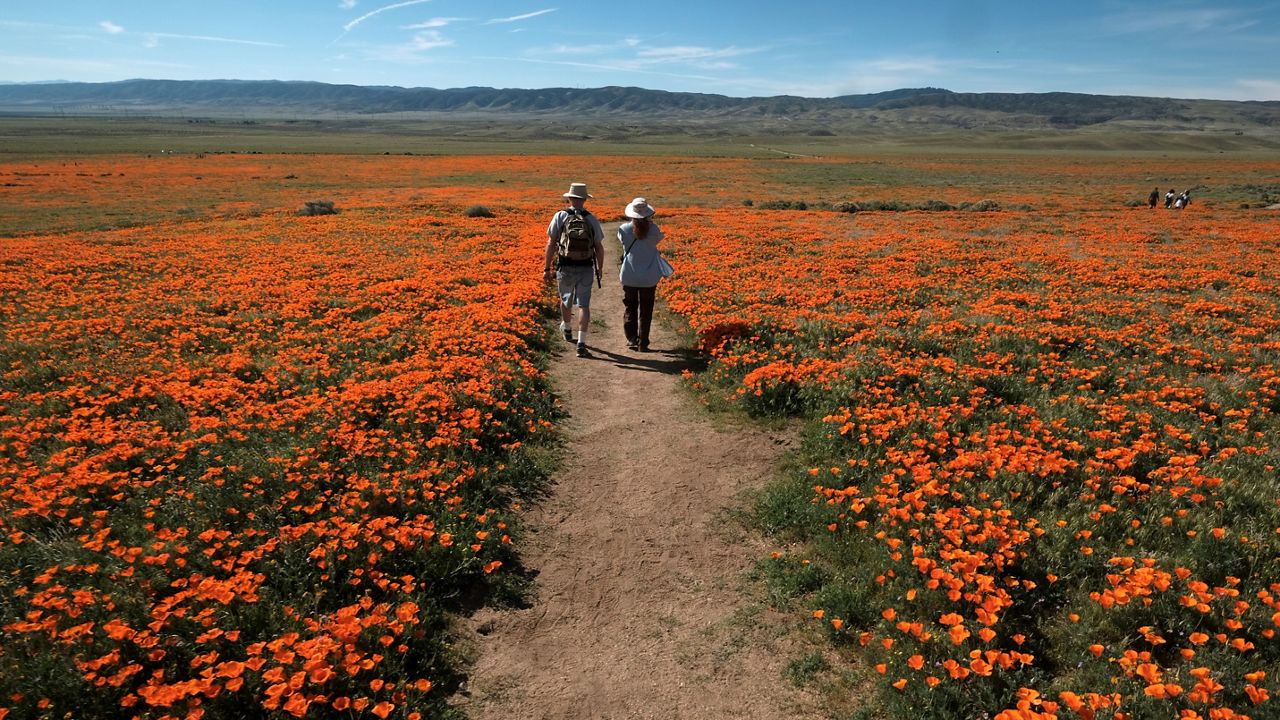Rain showers and mountain snow are a welcomed sign as the State Drought Monitor shows much of California still falls under the moderate to severe drought level.
With the rain comes a chance of seeing wildflowers in the springtime cover the once thirsty ground, but a super bloom of the magnitude of 2019 it will not be. You remember the one when freeways turned into parking lots, and the flowers could be seen from outer space. And let's not forget the crowds that, in their search of a selfie, failed to remember to leave no trace behind when in nature.
Here's how the wildflower season is shaping up at six popular places.
Anza-Borrego Desert State Park
While ecologists from the Colorado Desert District of California State Parks do not expect a "showy abundance" of wildflowers this year due to the less than two inches of rain received, the area is open for hiking.
According to the state park's website, a combination of sun, rain, wind, and temperature play a role in the arrival of the fields of flowers that have carpeted the area in past years.
"Don't count on a super bloom this year," the park's hotline warns visitors, adding that if they're up for the adventure, they might be able to spot one of the hundreds of flowering species hidden on the canyon trails.
Those wanting to stay on top of the latest wildflower updates at the park can call the Wildflower Hotline at 760-767-4684. The park's visitor center is also open and can be reached at 760-767-4205.
Antelope Valley California Poppy Reserve
A view through this California State Park's live stream showed the hills looking more brown than green. According to the California Department of Parks and Recreation website, the Poppy Reserve has received less than two inches of rain for the water year so far. That's a 1/5 of what is necessary for the wildflowers to blossom.
"Without significant precipitation spread out over multiple storms occurring in the next few weeks, it is becoming increasingly unlikely that we will see endless expanses of flowers like we have in 2017, 2019, and 2020," the website states.
But all hope is not lost as wildflower season generally lasts from as early as mid-February through May. Mother Nature could deliver drought-busting rain that quenches the barren hills. Until then, keep an eye on the live poppy reserve camera and the park's website for current photos.
Death Valley National Park
This park below sea-level is famous for its wildflower displays, but the conditions must be suitable for the flowers to bloom.
According to the National Park Service website, a dry fall, with rain and snow starting the last week of December, is unlikely to produce a large bloom at low elevations. That means that visitors must hike to at least mid-elevations for a chance to spot a few flowers, even on dry years.
The flowers may bloom in April and May at mid-elevations and into June in the mountains. Note that Death Valley National Park does not require an advanced entry reservation or pass to enter the park. Visitors can pay the fees upon arrival. Like other National Parks, this park is also following COVID-19 guidelines, meaning vendors are only accepting credit or debit cards, and visitors must wear masks wherever they can't maintain physical distance.
Idyllwild Nature Center
Spot the California Goldenrod, Gilia, Clarkia, and more while exploring this park on the perimeter of the mountain village of Idyllwild in Riverside County, which offers five hiking trails, rock climbing, and more. The cost for day use is $6 per adult, $3 per child 12 years and younger, and $2 per pet.
Walker Canyon in Lake Elsinore
Last year, officials deterred crowds from gathering at Walker Canyon amid the pandemic to see the wildflowers by prohibiting parking and issuing citations. It was another story the year before when more than 150,000 people showed up to view the rare poppy display, causing traffic jams and lines that snaked around as if it was Disneyland. While poppy season in this area runs from now through April, when the poppies bloom, "they will most likely die within two days because of the lack of rain."
Flower Fields at Carlsbad Ranch
On the rolling hills of North San Diego County lies more than 50 acres that blossom with colorful flowers that make a perfect backdrop to any photo. The primary type of flower grown at this working ranch is the Ranunculus flower. Due to COVID-19, there are several precautions that the Flower Fields are taking, including having everyone except those under 2 mask up, reducing visitor capacity, and asking parties to distance themselves from others. The fields will be open daily from 9 a.m. to 6 p.m. through May 9. Visitors must reserve tickets online. Admission is $18 for adults, $16 for seniors 60 and over, $9 for children 3–10, and free for children under 2.



